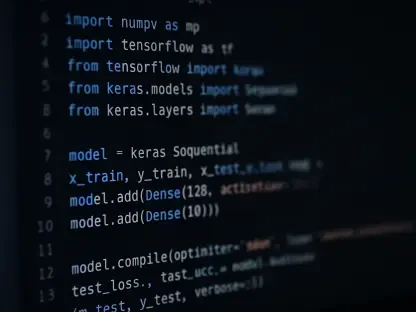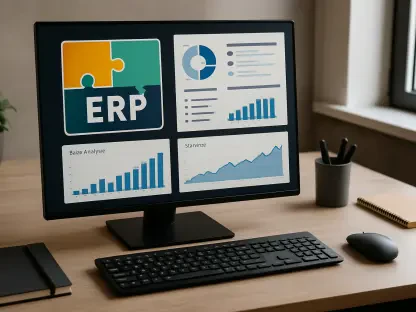Introduction to a New Era of Software Development
In an industry where efficiency dictates success, software development faces mounting pressure to deliver faster results without compromising quality, and developers often grapple with repetitive tasks and the daunting challenge of modernizing legacy systems. These challenges can drain resources and stifle innovation. Red Hat, a titan in the open-source software realm, has stepped forward with a transformative solution that promises to redefine productivity standards. This report delves into the impact of Red Hat Developer Lightspeed, a suite of generative AI tools designed to streamline workflows and empower developers to focus on high-value creative work.
The current state of the software development landscape reveals a growing reliance on AI-driven solutions to address complex challenges. As enterprises strive to stay competitive, the demand for specialized tools that cater to specific domains has surged, overshadowing generic models that lack contextual depth. This shift underscores the need for platforms that integrate seamlessly into existing ecosystems, a gap that Red Hat aims to fill with its innovative offerings.
This analysis explores how Red Hat’s latest advancements, including Developer Lightspeed and updates to the Migration Toolkit for Applications, are poised to reshape developer experiences. By examining core features, industry trends, and operational considerations, the report provides a comprehensive look at how these tools address pressing productivity hurdles while aligning with enterprise needs.
Unveiling Red Hat Developer Lightspeed: A Game-Changer in Software Development
Red Hat stands as a cornerstone in the open-source software industry, renowned for delivering robust solutions that drive enterprise innovation. The introduction of Developer Lightspeed marks a significant milestone, embedding generative AI capabilities into its ecosystem to elevate developer efficiency. This platform integrates with key tools like the Red Hat Developer Hub, aiming to transform how coding and application modernization are approached.
The significance of incorporating AI into development environments cannot be overstated. Unlike broad, general-purpose models, Developer Lightspeed offers context-aware assistance tailored to specific workflows, reflecting a broader industry pivot toward domain-specific AI. This focus allows for more precise support, addressing unique challenges developers face in real-time project scenarios.
Positioned among leading market players, Red Hat capitalizes on the rising demand for specialized tools that enhance productivity without disrupting established processes. As competitors also explore AI integration, Red Hat’s emphasis on customization and seamless compatibility sets it apart, reinforcing its role as a pioneer in adapting to evolving technological expectations.
Core Features and Functionalities of Developer Lightspeed
AI-Powered Assistance in Red Hat Developer Hub
Developer Lightspeed serves as a digital assistant within the Red Hat Developer Hub, offering support across a spectrum of tasks critical to software creation. From exploring application designs to drafting documentation, generating test plans, and troubleshooting issues, this tool reduces manual effort by providing intelligent, context-driven suggestions.
A standout feature is the “bring your own model” option, which grants organizations the flexibility to connect their preferred public or private language models. This customization ensures a balance between performance, cost, and privacy, catering to the diverse requirements of enterprises while maintaining control over sensitive data.
Such adaptability highlights Red Hat’s commitment to meeting varied user needs, ensuring that developers can leverage AI assistance without sacrificing security or operational efficiency. This approach aligns with the industry’s push for tools that integrate smoothly into existing systems while offering tailored solutions.
Streamlining Modernization with Migration Toolkit Integration
Developer Lightspeed also enhances the Migration Toolkit for Applications by automating source code refactoring directly within integrated development environments. This capability simplifies the transition of legacy applications to modern platforms, identifying potential migration hurdles and proposing actionable code modifications.
Beyond automation, the tool learns from previous projects, refining its recommendations over time to deliver increasingly accurate guidance. This adaptive learning process ensures that each modernization effort benefits from past insights, reducing errors and accelerating delivery timelines.
With the release of Migration Toolkit version 8, new automation features for replatforming workloads to Red Hat OpenShift have been introduced, starting with Cloud Foundry migrations. This update underscores Red Hat’s dedication to easing the burden of modernization, allowing developers to focus on innovation rather than repetitive refactoring tasks.
Addressing Productivity Challenges in Software Development
Software development is often hampered by mundane, repetitive tasks that consume valuable time and introduce the risk of human error. Manual processes, coupled with the intricacies of updating outdated systems, create bottlenecks that hinder progress and frustrate teams striving to meet tight deadlines.
Developer Lightspeed, alongside the enhanced Migration Toolkit, tackles these obstacles head-on by automating routine activities and offering AI-driven insights. By minimizing the need for manual intervention, these tools enable developers to channel their efforts into strategic, creative aspects of their work, thus boosting overall output.
Red Hat likely employs strategies to ensure these solutions integrate effortlessly into existing workflows, minimizing disruption. This might include compatibility with popular development environments and phased rollouts that allow teams to adapt gradually, preserving operational continuity while embracing technological advancements.
Navigating the Operational and Compliance Landscape
Implementing AI tools in software development necessitates strict adherence to operational standards, particularly in regulated industries where data security is paramount. Red Hat addresses this by designing Developer Lightspeed with features that prioritize compliance without sacrificing functionality.
Customizable language models play a crucial role in mitigating privacy and security concerns for enterprises. By allowing organizations to select models that align with their data protection policies, Red Hat ensures that sensitive information remains safeguarded, fostering trust among users.
Additionally, the cautious rollout of Developer Lightspeed in preview mode, bundled with subscriptions to the Developer Hub or Advanced Developer Suite, reflects a deliberate strategy to align with user expectations. This measured approach helps validate the tool’s effectiveness and compliance readiness before broader adoption, ensuring it meets enterprise-grade requirements.
The Future of AI in Software Development with Red Hat
Industry leaders at Red Hat have emphasized that the trajectory of AI lies in embedding intelligent assistance directly into developer workflows rather than focusing solely on model improvements. This perspective highlights a shift toward practical, integrated solutions that enhance day-to-day tasks over standalone technological advancements.
Potential enhancements for Developer Lightspeed could include broader integration with additional Red Hat platforms or advanced learning capabilities that further personalize assistance. Such developments would amplify the tool’s ability to address nuanced challenges, keeping pace with the dynamic needs of software teams.
Red Hat’s commitment to specialized AI positions it favorably to tackle emerging opportunities and obstacles in the development sphere. By staying attuned to market demands and fostering innovation, the company is well-equipped to shape the future of how applications are built and modernized, maintaining a competitive edge.
Reflecting on Red Hat’s Impact and Path Forward
Looking back, this exploration of Red Hat Developer Lightspeed and the updated Migration Toolkit reveals a strategic push to enhance developer efficiency through AI and automation. These tools tackle critical productivity barriers, offering solutions that streamline workflows and support modernization efforts with precision.
Moving ahead, enterprises and developers are encouraged to evaluate how such integrated AI solutions can be leveraged within their unique environments. Assessing compatibility with current systems and prioritizing tools that offer customization will be key steps in maximizing benefits.
Furthermore, staying informed about Red Hat’s ongoing advancements and participating in preview programs could provide early access to cutting-edge features. This proactive stance will enable teams to adapt swiftly to evolving industry standards, ensuring sustained growth and innovation in software development practices.









